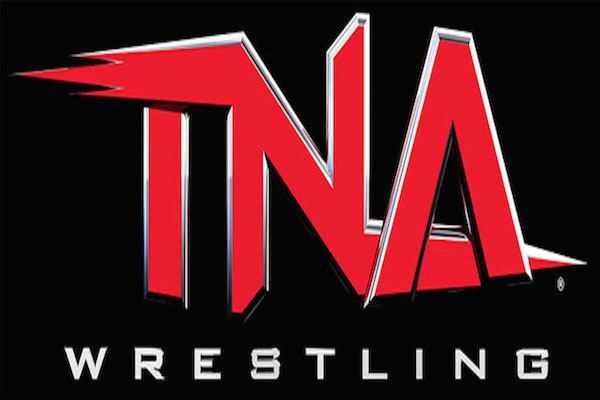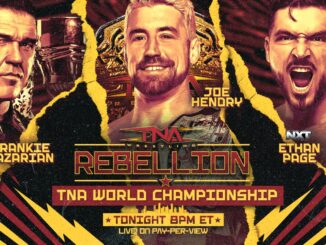
SPOTLIGHTED PODCAST ALERT (YOUR ARTICLE BEGINS A FEW INCHES DOWN)...
On Tuesday, January 5, TNA embarks on another new journey – a third TV home in three years. Will anything be different about the latest “new beginning” in Nashville?
The question will be answered by the actions at the top of the organization – TNA president Dixie Carter. How much has Carter learned from starts & stops and the company’s mismanagement over the past decade?
In 2015, TNA just needed a U.S. TV home after losing their sweetheart deal with Spike TV. They found a stop-over point with Discovery’s Destination America, which was essentially a deal to save face by not losing U.S. TV presence. But, Dest. America was so far down the totem pole of the Discovery family that TNA was not prioritized. Plus, Carter let her feelings about Dest. America be known in an email that sealed the fate of the relationship.
Now, TNA and Carter have shifted to the CBS/Viacom family of networks to partner with Pop TV, the former TV Guide Network. Again, like Dest. America, both sides of the relationship are looking for an identity far down the totem pole in the cable TV universe.
When the deal was signed, Pop’s president Brad Schwarz said the right things about the channel’s commitment to TNA and being dazzled by the potential of Impact Wrestling. Dest. America said similar things last year, but was not as excited as Schwarz sounds. But, how long will the honeymoon period last? How long will budgeting last to push Impact with ad-buys? How much patience will there be with TV ratings?
Dixie Carter wants to see TNA reach its potential on another cable TV channel. There’s a new vision, new marketing, a new website, new Creative input, and an attempt to bring in big names. But, it’s that last item that has created concern, feeling like a call-back to six years ago when TNA brought in Hulk Hogan and Eric Bischoff to kick off a short-lived Monday night run in January 2010.
Carter wants to be around stars and big personalities. She also wants to see herself as a star by association. But, how much of that has come at the expense of the company’s growth?
For wrestlers in TNA, they just want a consistent, week-to-week identity to wrap their heads around. In 2015, TNA went with a youth movement, then decided to flip over to a GFW invasion angle, then went through a three-month TNA Title Series that spilled over to 2016.
Wrestlers who have been through numerous Creative teams, numerous re-starts, and numerous visions just want something to sink their teeth into.
The issue is that TNA has not developed the backbone to support an operation that can be competitive in the marketplace.
When TNA regularly toured with live shows, they were too small to be big, but too big to be small. In other words, they tried to tour across the U.S. using their brand and some TV stars, but drew fewer fans than local independent shows who had a consistent presence in the marketplace. On the flipside, they were not big enough or did not have enough marketing dollars available to push live shows in local markets to draw decent audiences.
Going back to 2013, TNA took Impact on the road after the successful Lockdown PPV in San Antonio. However, that became too much of a financial burden.
The financial stress was not just from the talent roster, which was not getting paid on time due to accounting back-and-forth between Nashville and the corporate office in Dallas, but also added numerous production costs.
The hidden story about TNA’s lack of backbone is the production side of the operation. Wrestling reporter Brian Fritz blew open the story in 2015, noting that production team members were not being paid within the standard industry timeframe.
Key production workers walked, others felt like management was disinterested in solving the issue, and TNA brought in A01 Productions for Summer 2015 TV tapings. That did not work out, either, which will make for an interesting set of TV tapings in Bethlehem, Pa. this week to kick off 2016.
The unresolved issue goes back to ten years ago. Back in the FSN era of the mid-2000s, TNA’s production team was paid on time. Since TNA was not sure how long they would be in business, TNA promptly paid production workers after the TV tapings in Orlando.
Then, when TNA was in limbo between FSN and Spike TV airing shows on their website, TNA changed its way of paying production workers.
That carried over to the Spike era. The expectation was production workers would be paid within 30 days. That stretched to 45 days. Then, longer. By 2015, as Fritz reported on, the time period was 60 days, stretching the accepted industry standard. When it went beyond two months in 2015, that’s when production workers got frustrated, started talking to management, and eventually left the company.
The issue goes back to the mid-2000s when the pay structure changed, but workers felt like there was enough communication to address concerns. And, TNA was within the 45-day pay range, so workers were willing to work with the company – to a limit.
But, in 2013, when TNA went on the road for TV tapings, a lot of goodwill was lost. Because of all the changes, TNA was late with scheduling production workers. Workers had to follow the bouncing ball of TNA’s taping schedule, hurting their financial position.
The production workers are independent contractors who have other gigs in-between TNA tapings. So, workers ended up not being able to get other work while waiting for TNA to finalize dates.
TNA eventually stopped running TV tapings on the road because of the added costs and not putting forth the marketing effort to promote road-based TV tapings before returning to Orlando. Production workers again had to re-arrange their schedules and outside bookings to be available in Florida.
“We started in mid-March and by mid-summer we were having cash flow issues,” said one former production worker. “Then TNA started cutting the roster and some production people went away, then some came back. The whole time that Impact Wrestling was ‘on the road,’ it was never marketed.”
After the road experiment in 2013, there was uncertainty over TNA’s TV future in 2014. Talent were left in the dark, which Dixie Carter publicly attributed to not being able to discuss negotiations until finalized with Destination America. Some talent left the promotion, which production workers noticed.
“Most freelancers won’t work for the show because of the paying on-time issue and noticing that the wrestler roster is downsized significantly,” the production worker added.
In 2015, TNA started the year taping TV in New York with low lighting that was necessary because of costs, not for aesthetic reasons. Production workers noticed the quality of the product dipping. Then, many key workers left the company, especially as TNA remained late with payment, which extended to Bound for Glory in October. There was also another round of uncertainty because of the false start to the TNA-Dest. America relationship before the Pop TV deal was announced.
The internal issues point to a lack of backbone for the business to successfully operate. TNA has the financial backing of Panda Energy, but TNA’s operations need to be cleaned up. That starts at the top with Dixie Carter and other key positions, including the wrestling side of the business.
“Dixie has people surrounding her with no real success,” said a second former production worker. “People are telling her what she wants to hear.”
MVP, who was a big free-agent signing for TNA two years ago, commented on the structural issues during a recent edition of the Sam Roberts podcast.
“You can have alternatives to [WWE], but there is no competition. In my opinion, certain people in managerial roles at TNA leave a lot to be desired and that’s the reason TNA is in the situation it’s in right now,” MVP said. “They’ve been around for 13 years. At this point, they should be a solid secondary alternative to WWE [and] well in the black, but they’re not.”
Instead, the focus goes to putting another coat of paint on the house built on shaky ground. New website, new logos, new marketing, new talent, etc. But, how will any of it last when the structure needs repair?
TNA has stayed afloat thanks to Bob & Janice Carter’s Panda Energy company. Every year, the question is whether this will be the year that Panda finds a buyer. Every year, though, TNA keeps on trucking.
Going forward, it would help to address the basic function of the payroll department, which continues to undergo changes, as Dixie Carter noted in an interview with Sports Illustrated in September.
“Our accounting is in Dallas, and we’re changing and shifting that to Nashville,” she explained. “It’s not a matter of not having the money, and it’s happened – maybe – a couple of times, at most, in 13 years. It’s not a function of not having the money, so we’re trying to simplify the issue and bring accounting to Nashville.”
Now, TNA has a money stream from a third TV partner in three years. TNA and Pop TV are not disclosing the financial terms of the deal, but Pop’s Schwarz confirmed that it is a multi-year deal. And, includes a commitment to see TNA through the latest changes.
“We are a channel that is owned by CBS and Lionsgate. We all have extraordinarily large dreams of where we can take this channel. What I can guarantee you and promise you is that we would never whore out our prime-time to an infomercial,” Schwarz told Jim Varsallone of the Miami Herald in November.
“It’s a multi-year deal, and we are joined at the hip in making it as successful as possible and monetizing it together. Unlike the networks it’s been on in the past, you’re going to see promos on the air, promoting it every single week. A good amount of promos every single week, all 52 weeks of the year, promoting Impact Tuesdays at 9 p.m.
“We want it to be the biggest show on our network. We are very excited to have this show on our network on Tuesday nights. I hope it’s a huge hit and stays there forever. Our job now is to make the other six nights of the week big.”
Now that Carter has a committed TV partner, will she take advantage? Or, will other desires continue to be at the forefront over solid business practices like making sure talent and production workers can put money in their bank account?
Carter has enough business acumen to find a new TV partner in Pop, and the right people are in place overseas to develop markets like the U.K., where TNA returns in January But, at home in the U.S., where WWE is king, TNA will be a very distant #2 until TNA and Carter decide to take business operations serious enough to make changes.
Accountability, communication, and a sense of care for others’s well-beings would be good starts.
Carter gets another fresh start to begin 2016. Not just with new graphics and a website, but starting to implement structural changes that will help the company grow and be a solid home for wrestlers, production workers, and office staff to be feel proud about, not look back at sadness at the missed opportunities because TNA did not have a structure to take advantage of financial resources and a long list of stars who have come through the locker room.
Carter’s legacy in the wrestling industry might depend on what TNA looks like after getting another year in business.




Neckbeards sound stupid when they mock “Ditzie” Carter. But none of us know what goes on behind the scenes to get these TV deals, or what the conversations Bob and Janice Carter are like at Christmas parties.
I’m at least glad someone out there is willing to put money into wrestling. If I had the money, I’d love to be a big time promoter. But I’m not. I’m just Chad.
TNA! WWE!